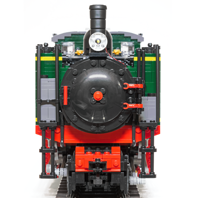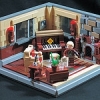Search the Community
Showing results for tags 'apollo'.
Found 13 results
-
Ever since I got my 21309 Saturn V, I thought it would be cool to have a model of the launch tower to go with it. Well, it may be a long time before I get a chance at building this model for real, but I have completed the digital design! If anyone is interested, an LDD file is available from my bricksafe page: https://www.bricksafe.com/pages/NathanR/real-space/apollo-lut Original first post: Ever since I got my 21309 Saturn V, I thought it would be cool to have a model of the launch tower to go with it. I'm clearly not the only one because a similar model recently reached 10k votes on Lego Ideas - however, I'm impatient and so I decided to start building my own. I've been working in LDD due to a lack of physical bricks, and the first (very rough) sketch model is complete: The Saturn V rocket was launched from the Mobile Launch Platform (MLP, nothing to do with ponies...), a two story structure on which the rocket was constructed and fuelled. It measured 169x135 feet, or 56x46 studs at 1:110 scale, and also carried a 380 ft tall launch umbilical tower (LUT). The tower featured nine arms that provided electricity and other services to various parts of the rocket, and swung away just a fraction of a second before it blasted off. The rocket did not stand on the engine nozzles, but was instead suspended over a single exhaust vent measuring 45x45 feet. This should be 15x15 studs but I've gone with 14x14 studs for ease of building: I'm particularly proud of the design of the hold down arms: These four clamps held the rocket down until all five engines were confirmed to be running at full power, at which point they retracted behind heat-proof shields and allowed the Saturn V to soar skywards. Three additional holddown arms were located around the pad and have yet to be modelled. I'll add details once I have the core structure sorted. The base of the MLP uses 1x4x6 door frames like the version that was on Lego Ideas - an inspired choice which I've temporarily copied here (I'm actively trying to avoid looking at the Ideas model so I don't copy it), but I'm toying with 1x1x5 bricks to represent the support columns instead. I could really use some help and advice with this model though. How do I make it structurally sound? The MLP is a glorified box with a hole in it, but I've never built anything this big before and I'm not sure how to link together the baseplates. I had a few ideas for some internal supports: Do you think these would be strong enough? Should the outer wall be thicker? Should I criss-cross the entire hollow space with brick beams? How do I strike a good balance between strength and low parts count? You can view larger pictures and find the LDD file on bricksafe. If there's interest I'll make instructions available when the model is complete. Any advice or constructive feedback would be much appreciated!!
-

[MOC] Lunar Roving Vehicle (Micro version for Saturn V)
Sven J posted a topic in Special LEGO Themes
Hi all, Inspired by a much larger model of NASA's Lunar Roving Vehicle, I tried to design a micro version to match with the Saturn V model. Here's what I came up with... It' s not perfectly the same scale as the Saturn V, but, at quite exactly 1/100, comes close enough. The whole thing consists of no more than 10 pieces: I'm quite content with how it looks beside the Saturn. You can find the .io file here. Thanks for stopping by! Best regards, Sven -

Saturn V Launch Pad with Umbilical Tower
teflon posted a topic in LEGO Technic, Mindstorms, Model Team and Scale Modeling
I'ts been a while since I finished this model, probably some months after getting my hands on original Saturn V. The latter seemed lonely on the shelf and it was my mission to build it a company. As an engineer I always admired these large structures but always been too lazy to do something in that direction. After seen the proposal at Lego Ideas for Umbilical Tower, I started to gather ideas, pictures and most important the - bricks. Since 20th of July marks 50 anniversary, it seemed like a good idea to present this project. Therefore I took model from the shelf, dusted of some dust and took some new pictures. The last time I didn't get the time since I was running late for our BrickFest. 1. Planing and Building As any good creations, this started as a plan, something like this: The next step was scaling. I am sorry Sariel, but I am more familiar with pen and paper than your great tool (the top should be at aprox. 140 studs). The internals of the Launch pad was made out studded technic bricks which are quite suitable for carrying a lot of load. These proved vital in the later stage when Pad is occupied with the tower and Saturn V. The outside was tiled with tiles and the building of the tower could go on. The most critical component was how to attach the tower to 4 points, while allowing beams to be at angle in both direction (from the plans and pictures it could be seen, that tower is getting narrower and thinner at the same time). A person is added at the corner to get a feeling of a scale of the tower. The solution is presented here, an angle connector at 157.5°: 2.The Big Thing The result is here: I've tried my best to show the whole thing but my dining area seems too small. It looks more beautiful with Saturn V: And picture from behind: On the top there are some knobs to conrol the support rods, the position of the white room and the top support above the capsule. Please note that crane is also fully operational. Another picture of the top with crane in lift-off position. The central column (gray) has room for an elevator, however it was not added since it would be very difficult to observe White room and the Apollo 11. I hope the astronaut on the plank is not late. And bottom up view. 3. Details Mobile transporter is simplified to the bone: just some necessary things. And of course it should be capable of having a tone of bricks on its shoulders: A functional crane is simple but I hope it adds to the character of the tower Pad is almost clear with exception of some service buildings Some more files can be found at my Bricksafe page. I hope you like it. It's always an conversation starter at home. Please feel free to comment or ask a question. -
Hi all, I just finished the reimagined battlestar galactica, and it was phenomenal. So, I just had to build myself a viper. It has landing gear that raises and lowers, and it can fit one pilot. Enjoy! Colonial Viper Mk. II (1) by [DustyBricks], on Flickr Colonial Viper Mk. II (2) by [DustyBricks], on Flickr Colonial Viper Mk. II (3) by [DustyBricks], on Flickr Colonial Viper Mk. II (4) by [DustyBricks], on Flickr Colonial Viper Mk. II (5) by [DustyBricks], on Flickr Colonial Viper Mk. II (6) by [DustyBricks], on Flickr Colonial Viper Mk. II (7) by [DustyBricks], on Flickr
-

21309 NASA Apollo Saturn V [VIDEO REVIEW]
Sariel posted a topic in LEGO Technic, Mindstorms, Model Team and Scale Modeling
I'm not sure if reviews are welcome in this part of the forum, but it seemed to me like a more fitting place than e.g. historic themes. If I'm wrong, please move the thread. Pros and cons followed by TWO videos below (a review and a separate speed build video): Pros: - incredibly BIG, surprisingly detailed and accurate - comes with a beautiful instructions book featuring the whole story of the Apollo 11 program; a wonderfull lesson in history - includes unique and useful printed pieces and nice nanofigures, too - great display set; the rocket can be displayed vertically or horizontally, and accompanied by the Moon landing and splashdown scenes - features craziest building techniques I've seen in an official LEGO set - relatively cheap at 5.6p / 6.1c per piece Cons: - limited playability; primarily a display set - very tall and quite heavy; easy to knock down and thus potentially unsafe for young children - wanting instructions; to properly reenact the Apollo 11 mission, you need to alter the CSM module in a way not explained in the instructions - can be difficult to build due to the very unusual building techniques being used - parts of the build are pretty boring, as you have to build 4 copies of the same part repeatedly -
Building Nasa Apollo Saturn V 21309 Timelapse Nasa Apollo Saturn V Lego 21309 Timelapse
-
Hello all,I've been so excited for the release of LEGO's Saturn V Rocket that I have been slowly designing and constructing the mobile launch tower and crawler to create a more complete display look! I will admit, throughout the process I came across other folks creations (Eiffleman, Valerie Roche and Emmanuel Urquieta) and borrowed some of their designs/ideas to improve and implement into my creation. It does not have the cool playability features as theirs do! IMG_20170709_130956846 by Anthony Foss, on FlickrThe crawler is built off the pictures sent into Lego Ideas by Eiffleman. I had to reinforce the crawler to support the weight of the tower. The crawler essentially collapsed under the pressure of the tower and rocket positioned on top the first go around :)The tower is a relatively easy build. Each of the levels is essentially the same. For the white piping running up the front side of the tower I used a flexible rubber hose, similar in diameter to the rigid pneumatic tubing LEGO uses (saved a little bit of money). Stability becomes and issue the higher you build. It works but not as sturdy as I would like. A solid base is a must. The catwalks are a lot of torque on the tower than it seems. I went through a few designs before I got one that doesn't sag.It was nice to see one of these in person instead of a LDD image. https://flic.kr/s/aHsm4uqqFD
-
On February 20th 1960, U.S astronaut John Glenn became the first American to orbit the Earth. Piloiting the Mercury capsule “Friendship 7”, launched atop a newly up-rated Atlas rocket, he successfully made three orbits of the Earth. The mission suffered various glitches, including thruster issues and a possible loose heat shield (which could have been fatal), but was essentially a complete success and paved the way for future American space exploration. (Base image from Wikipedia) This particular model is in scale with the recent Lego Ideas 21309 Saturn V/Apollo rocket. I’ve taken the scale from the Apollo command module, assuming 1 stud = 1m. The Atlas rocket was a 1.5 stage rocket. Unlike the Saturn V, which dropped complete assemblies of fuel-tanks and engines, the Atlas rocket jettisoned it’s two outer engines on the way to orbit. This is possible on the model: The Mercury-Atlas comes with a separate Mercury capsule on its own display stand - this version includes a 1x1 round plate on the base to represent the retro-rocket pack. This was used to de-orbit and return Friendship 7 to Earth, but unfortunately there isn't the space to include it on the rocket stack. The Mercury capsule is topped by a 4.8m red escape tower, which would propel the capsule up and away from an exploding booster. While never used on manned flights (fortunately), it saw incredibly frequent use during the Atlas rocket's early testing! A nanofigure astronaut is included for scale… and yes, Mercury really was that tiny!! This is a digital MOC and hasn't been tested in real life. Comments and criticism is always appreciated - I would also welcome advice on how to build a suitable display stand. There’s no way the rocket can stand on its engines, and not many connection points left near the base!
-
Hi there, here is a creation made with LDD, the Apollo Lunar Module. I imported the creation in mecabrick and then exported it to blender to render it. The creation itself counts 825 bricks and, in my opinion, looks more realistic than the one made by TLC (Lego set 10029) : Rendering test by dorian glacet, sur Flickr
-

Apollo CSM, Lunar Module & Lunar Rover at Minifig Scale
lpglego posted a topic in Special LEGO Themes
The Apollo Program is a key part of the history of space exploration. The most famous missions were the Apollo 11 (first manned moonlanding) and Apollo 13 (that inspired the movie starring by Tom Hanks). This LEGO project includes: Apollo Spacecraft Command and Service Module (Apollo CSM). The model can be separated into its command module and the service module. The Command module has a hatch (that can be opened) and fits 3 astronauts inside (included). The CSM comes with a stand that fits the spacecraft. Lunar Module. This is the spacecraft used for the moon landing. It can be separated in the ascent module (upper part) and descent module (lower part). The ascent module can be opened and fits two astronauts. Lunar Roving Vehicle.It was an electric-powered vehicle designed to operate in the low gravity of the Moon, and allowed the Apollo astronauts to extend the range of their surface extravehicular explorations. The LRV was populary known as the "moon buggy". Three LRVs were driven in the Moon: in the Apollo 15 mission during 1971, and Apollo 16 and Apollo 17 during 1972. This project is also posted at LEGO Ideas https://ideas.lego.com/projects/140420 You can find more HR pictures at my flickr album: https://flic.kr/s/aHskCBsRUD Kind regards Luis -
Hello everybody: this is my Apollo 11, I hope you like it. CM, SM and LM can be separated. The CM fits 3 astronauts. 1196 pcs. You can find details of it at LEGO Ideas https://ideas.lego.com/projects/84718
-
A bit late to the party, but last Monday was the 46th Anniversary of the first Lunar Landing. 46th Anniversary of the first Lunar Landing The 46th anniversary of the first moon walk is a day that space buffs everywhere still celebrate. More than a half billion people watched the televised first moonwalk July 20, 1969, where Neil Armstrong uttered the now-famous words, "That is one small step for man, one giant leap for mankind." Astronauts Armstrong, Edwin "Buzz" Aldrin and Michael Collins left Earth on July 16 from Cape Kennedy in Florida. Armstrong and Aldrin stepped onto the moon a few days later. The men spent 21 hours, 36 minutes on the moon before joining back up with Collins in the command module. The mission accomplished the objective set by President John F. Kennedy in 1961, which was to land a man on the moon then return to Earth. CBS Coverage of Apollo 11 Lunar Landing Apollo 11 - Saturn V Being an avid fan of everything that has to do with space and space travel, it's obvious I love to see great LEGO space projects. I especially like iconic projects depicting historic scenes. One of the most iconic space crafts is the Lunar Lander called Eagle carried into space by the Saturn V missile, during the Apollo 11 mission. Recently I stumbled upon a great project on LEGO Ideas, based on this event. The project is created by EB member Saabfan and it comprises the Saturn V missile and all modules used during the mission. The rocket is about 1 meter/130 studs high (aprox. 1:110 scale), has 1179 bricks and lots of features: Removable 1st rocket-stage with the main rocket engine Removable 2nd rocket-stage with rocket engine Removable 3rd rocket-stage with the Apollo spacecraft Apollo spacecraft with the "Eagle" Lunar Lander and the Lunar Orbiter The rescue rocket on top of the whole spacecraft Two minifigure astronauts on the Moon for displaying Apollo 11 CMS and Lunar Lander Below is a great picture of the Eagle (Lunar Lander) and in the background you see the Columbia CMS (Command/Service Module). The flag you see in the image is not there anymore. Buzz Aldrin saw it knocked over by the rocket blast as he and Neil Armstrong left the moon. This is a picture of the Eagle still connected to the CMS. Here's detailed picture of the Saturn V missile designed by Werner von Braun and the probably less known Arthur Rudolph. Here you see all the modules comprising the complete (proposed) set. It shows the EMV (Emergency Escape Vehicle) on the left, followed by the Command Module, Service Module, Lunar Lander and the different stages of the rocket. Neil and Buzz doing research on the surface of the moon, with the lander in the background. Don't know about you, but I would love to have this set on my shelf
-

needhelp for apollo astronaut
knistertoni posted a topic in Digital LEGO: Tools, Techniques, and Projects
hey! i need some help, because i want to build something for a friend. as an attachment you can find what i have already built and some pictures of what it should look like afterwards. the problem is, i am not that much into LDD :-( hope someone can help lxf files and pics: arme.lxf astro.lxf




